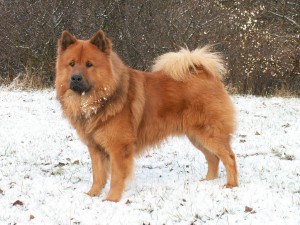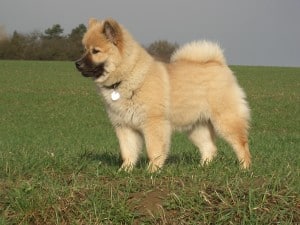
This dog is very tolerant of children, and is a devoted companion; he must have contact with his people, and does not do well as a yard or kennel dog. The Eurasian is very adaptable, and can live in almost any environment, whether urban or rural. It is very alert and can be a good watchdog, without the problem of excessive barking but the Eurasian is known for barking when it is necessary. The Eurasian does not have any hunting instinct, which makes him easier to manage than many other breeds.
The Eurasian is an attractive medium sized dog of typical Spitz type. He has a compact, well-balanced body with medium bone. His head is a typical wedge shape with prick ears and dark, slightly slanted eyes, with an alert, intelligent expression. He carries his tail curled over his back, and has a brisk, ground-covering gait. Characteristic of the breed, is the thick, profuse coat, consisting of medium long outer coat and soft and wooly undercoat. The Eurasian comes in a wide variety of colors – all colors are acceptable except pure white, white patches, or liver. There are some variations in type due to the mixed heredity of this breed.

The German club has been very careful in breeding only from the most suitable and healthy stock and has established the Eurasian as an excellent family dog.The Eurasian should have regular daily exercise – it is an alert and active dog and enjoys physical activity. The coat requires regular brushing, at least once or twice a week, and more in the shedding season. Health concerns that should be watched for in this breed are hip dysplasia, elbow dysplasia, patella luxation, entropium, ectropium, distichiasis.
